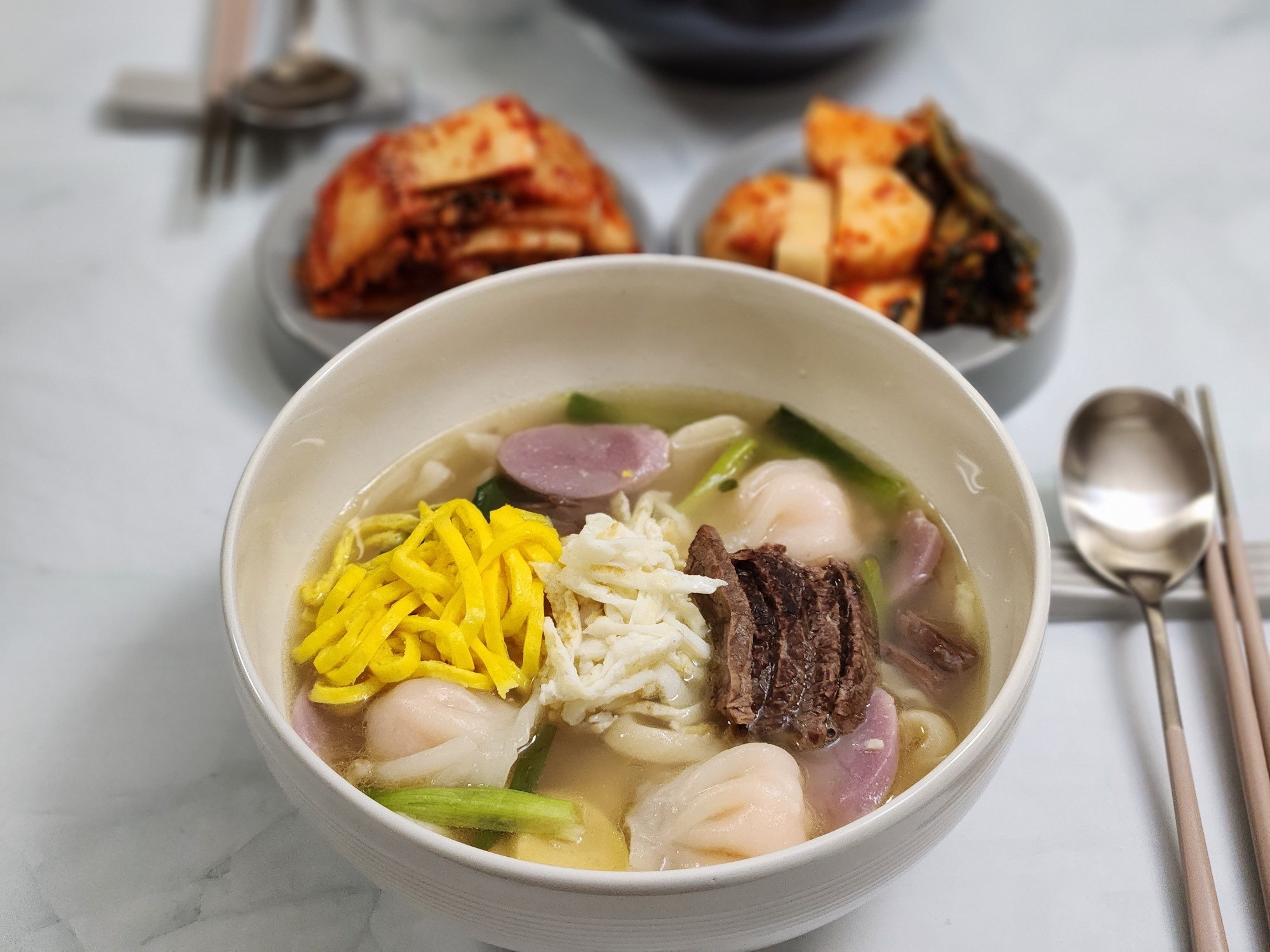Rich and Clear Beef Rice Cake Soup (Tteokguk)
Essential for Holidays! Golden Recipe for Beef Rice Cake Soup (with Tips for Tteokmanduguk and Brown Rice Tteok)

This is a delicious recipe for Beef Rice Cake Soup, featuring a rich broth simmered from beef. You can enjoy it with chewy brown rice tteok (rice cakes), hearty dumplings, and tender beef. I’ll share my secrets for making a clear and deeply flavorful beef broth without any gamey odor, along with detailed instructions for preparing this festive and tasty tteokguk. It’s also perfect as Tteokmanduguk (rice cake and dumpling soup).
Main Ingredients- Brown rice tteokguk tteok or regular tteokguk tteok 200g
- Dumplings 6 pcs
- Beef (stewing cut, block) 300g
- Eggs 2 pcs
- Scallions 2 stalks
- Water 1.5L
- Beef bone broth (store-bought) 300ml
- Sesame oil 2 Tbsp
Seasoning & Garnish- Korean soy sauce for soup (Guk-ganjang) 1 Tbsp
- Perilla oil 1 Tbsp
- Tsuyu (Japanese soy sauce) 2 Tbsp (or fish sauce/tuna extract 1 Tbsp)
- Cooking wine (Mirin/Masul) 2 Tbsp
- Minced garlic 1 Tbsp
- Salt (to taste)
- Pepper to taste
- Korean soy sauce for soup (Guk-ganjang) 1 Tbsp
- Perilla oil 1 Tbsp
- Tsuyu (Japanese soy sauce) 2 Tbsp (or fish sauce/tuna extract 1 Tbsp)
- Cooking wine (Mirin/Masul) 2 Tbsp
- Minced garlic 1 Tbsp
- Salt (to taste)
- Pepper to taste
Cooking Instructions
Step 1
First, let’s prepare the rice cakes (tteok). I’m using 200g of tri-colored brown rice tteokguk tteok. If you’re using frozen tteokguk tteok, it’s best to use them directly without soaking them in water. Brown rice tteok is chewier and has a nuttier flavor than regular white rice tteok, and it cooks a bit faster.

Step 2
For the beef, I’ve prepared 300g of stewing cut beef in a block. It’s crucial to soak the beef in cold water for about an hour to remove the blood. Change the water about three times during this process for a cleaner broth. Even if you buy pre-sliced beef, it’s a good idea to soak it to remove blood.

Step 3
Place the blood-removed beef in a pot and add enough water to cover it. Bring it to a boil over high heat. Once boiling, turn off the heat, remove the beef, and rinse it thoroughly under running water. Even after soaking, boiling and rinsing helps remove impurities and residual blood, ensuring a clear, odor-free broth.

Step 4
Now, let’s make the broth. Add 1.5L of fresh water to the parboiled beef and bring it to a boil over high heat. Once it boils, reduce the heat to medium-low and skim off any foam that rises to the surface. Partially cover the pot and simmer until the beef is tender, about 1 hour.

Step 5
After simmering for 1 hour, the beef should be tender. Remove the beef from the pot and let it cool slightly. Then, thinly slice a small portion for garnish.

Step 6
We’ll be making yellow and white egg garnishes. Separate the two eggs into yolks and whites. Add about 2 tablespoons of the egg white to the yolk bowl – this helps prevent the yolk garnish from breaking. Whisk both the yolk and white mixtures well with a pinch of salt.

Step 7
Gently preheat a non-stick pan over low heat with 1 tablespoon of sesame oil. Pour in the egg yolk mixture. Once the surface of the egg pancake looks set and slightly bubbly, flip it over and cook briefly. The white egg garnish is quite delicate. It’s best to prepare the yolk garnish first to ‘season’ the pan, then cook the white garnish.

Step 8
Next, add another tablespoon of sesame oil to the pan over low heat and pour in the egg white mixture. Cook until the surface looks set and slightly dry. Instead of flipping, carefully slide the egg pancake onto a plate to cool. White egg pancakes are very fragile and can easily tear if flipped.

Step 9
Once the egg pancakes have cooled, roll them up tightly and slice them into thin strips for garnish.

Step 10
Shred the remaining sliced beef that was set aside for garnish into bite-sized pieces. Shredding makes it easier to eat and looks more appealing as a topping.

Step 11
The beef broth from simmering yielded about 1L. We’ll add 300ml of store-bought beef bone broth for an even richer and deeper flavor. Using store-bought bone broth makes it easy to achieve a rich soup without having to boil bones separately.

Step 12
Now, let’s season the broth. Add 1 Tbsp Korean soy sauce, 2 Tbsp Tsuyu, 1 Tbsp perilla oil, and 2 Tbsp cooking wine for a savory depth. If you don’t have Tsuyu, you can substitute it with 1 Tbsp of fish sauce or tuna extract.

Step 13
Add 1 Tbsp minced garlic. Taste the broth and adjust the seasoning with salt if needed. Bring the seasoned broth to a gentle simmer.

Step 14
Once the broth is boiling over high heat, add the shredded beef and dumplings. Once it returns to a boil, add the tteokguk tteok. Stir gently just once to prevent the rice cakes from sticking together. Avoid stirring too frequently after adding the tteok, as it can cause them to break apart and make the soup cloudy.

Step 15
The rice cakes are cooked when they float to the surface. Add a handful of chopped scallions (or green onions) and stir briefly before turning off the heat. The fresh aroma of scallions will enhance the soup’s flavor.

Step 16
Ladle the finished Beef Rice Cake Soup into bowls. Garnish with the yellow and white egg strips and the shredded beef. Finish with a sprinkle of pepper for an aromatic touch. Enjoy your delicious and festive Beef Rice Cake Soup!



